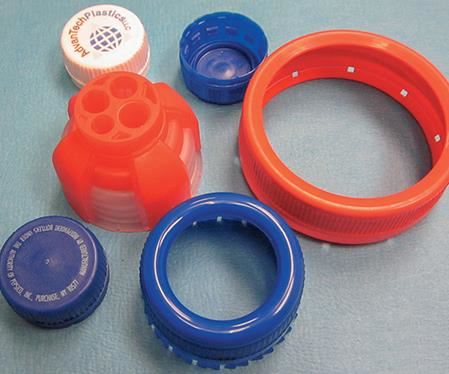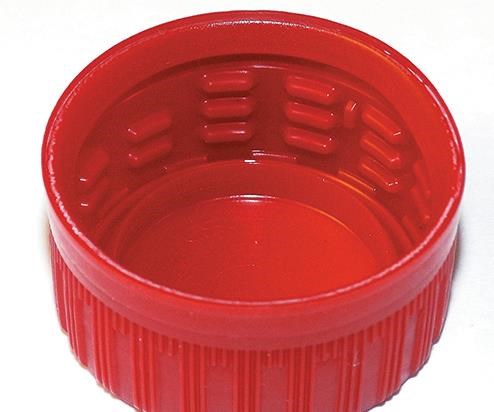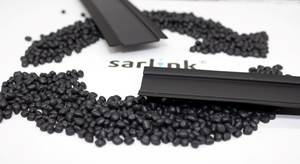AdvanTech Hopes To Open Up New Closure Market
CAPS AND CLOSURES
A linerless, one-piece injection molded cap for carbonated soft drinks cuts weight dramatically.
This month, a completely new concept in carbonated soft-drink (CSD) closures, promising equal or greater performance from less resin, will begin commercial production in Woodstock, Ill. AdvanTech Plastics LLC, via its AdvanTech Closures LLC business, will introduce a one-piece, linerless, injection molded PE closure to North America, competing with the market’s standard two-piece PP cap with elastomer liner.
Al Zoller, CEO of AdvanTech, recently gave Plastics Technology a first look at the type of molding cell that would produce the revolutionary cap. Located in the company’s newest facility, just a six-minute drive from its custom molding operation in Woodstock, the cell is built around a HyCap 400 press from Husky Injection Molding Systems, running a 96-cavity tool from Austria’s z-moulds.
Originally introduced in 2011, with early adopters in Australia and parts of Asia, the single-piece 1881 CSD finish standard marked a wholesale departure from the two-piece elastomer liner and PP cap, which still dominates the market. AdvanTech’s second-generation 1881 cap, with patented Flex Seal technology, has evolved further still, cutting weight by 20% from the first-generation 1881, down to just 2.1 g.
After exhaustive testing, including integration into bottling and filling plants, the cap received final approval from a major soft-drink manufacturer this year and will go into production when several of that company’s closure contracts are up for bid. This sets up 2016 as the year that one-piece injection molded CSD closures could establish a beachhead in North America. Before that was possible, the new design had to be completely vetted, with comprehensive testing, including application torque, removal torque, carbonation, carbon dioxide retention, and every imaginable dimension verified on all 96 cavities of the production tool.
SEEKING CLOSURE FOR A NEW CLOSURE
In 2001, Zoller took over the company that he would eventually rename AdvanTech in 2005. The company’s original building, which covers 27,000 ft2, is more than 70 years old and was home to the former Plasticraft tool shop. This facility, which houses 17 presses ranging from 55 to 400 tons, runs a variety of jobs from automotive to medical. In 2012, AdvanTech added a second plant three miles away, which covers 65,000 ft2, and is home to the linerless closure program. At present, AdvanTech is occupying only about 60% of that facility with six presses, ranging from 300 to 400 tons.
The new facility’s three rail spurs and six material silos were of particular interest to Zoller, given his ambitious closure-molding plans. “It’s built to do this kind of large-scale molding operation,” Zoller said of the site. If the linerless cap launch goes well, three fully equipped cells with a total of six machines will handle production with two 96-cavity molds and one printing line, Zoller said. The laser-printing operation will eventually include the ability to add barcodes to the underside of the closures, which can be scanned by consumers as part of the soft-drink maker’s promotional activities.
The 96-cavity tool runs a 3.7-sec cycle. Parts are fed to the printer, which can run up to three colors at 3000 pieces/ min. Since the mold can create more than 1500 caps/min, two molding machines can feed a single printer with the new closure.
In operation, the 96-cavity tool drops closures onto a conveyor, which feeds into a “waterfall” post-mold cooling system. From there, caps are oriented right-side-up and lined up single file for top printing via technology from Desco Machine Co., Twinsburg, Ohio. A vision system from Swiss firm IMD Vista performs 100% inspection and rejects faulty closures for print defects or dimensional deviance. AdvanTech has multiple closure customers, including ones for hot-fill caps with metal inserts and large 63-mm closures for products like jelly.
SEEKING A NEW STANDARD
“The current caps, which are a heavier design, are molded in PP,” Zoller said. “The trend is towards HDPE, which we are using. There’s a variety of dynamic characteristics that really allow HDPE to be more effective in the one-piece sealing system.”
Noting that CSD bottles with the new caps should be on store shelves this month, Zoller is optimistic that his company is at the forefront of a step change for the sector. “We are hoping that the industry will to want to standardize on new caps, and this design is one of them,” Zoller said. “We’re up for being chosen to be one of the designs to be standardized on, and because of that, we anticipate big growth.”
How big? According to an April 2015 report by market researcher Freedonia Group, Cleveland, global demand for caps and closures is pegged to increase 5.6%/yr to $58 billion by 2019, with unit production rising 4% to 2.2 trillion. Beer, CSD, and bottled water represent the largest segments.
The market is also big enough to spur competition. In 2013, Closure Systems International (CSI) in Indianapolis introduced a compression molded, one-piece, linerless 28-mm (1881 bottle finish) closure for CSD and sparkling beverages. John Greiner, CSI’s director of global business development, told Plastics Technology that CSI’s one-piece cap, the Omni mini XP, has been adopted commercially in the U.S. and Europe by the majority of its “key carbonated-beverage customers.”
Related Content
Advanced Plastomers for Production of PE-Based Sealant Resins
Nova Chemicals’ new Astute products are suitable for a broad range of applications including food packaging, heavy-duty sacks and e-commerce.
Read MoreMulti-Purpose TPV with Post-Industrial Recycled Content
Teknor Apex’s new Sarlink R2 3180B TPV offered with 25% PIR content.
Read MoreFast-Cycling Selective Laser Sintering System
Nexa3D announced the QLS 260 for metal and polymer production.
Read MoreTracing the History of Polymeric Materials -- Part 30: Polyurethane
In the world of polymers, polyurethane chemistry is probably the most versatile. This a resulted in a wide range of products made from these materials and given the industry the flexibility to respond to the progressive march of regulatory concerns.
Read MoreRead Next
Advanced Recycling: Beyond Pyrolysis
Consumer-product brand owners increasingly see advanced chemical recycling as a necessary complement to mechanical recycling if they are to meet ambitious goals for a circular economy in the next decade. Dozens of technology providers are developing new technologies to overcome the limitations of existing pyrolysis methods and to commercialize various alternative approaches to chemical recycling of plastics.
Read MoreUnderstanding Melting in Single-Screw Extruders
You can better visualize the melting process by “flipping” the observation point so that the barrel appears to be turning clockwise around a stationary screw.
Read More



























